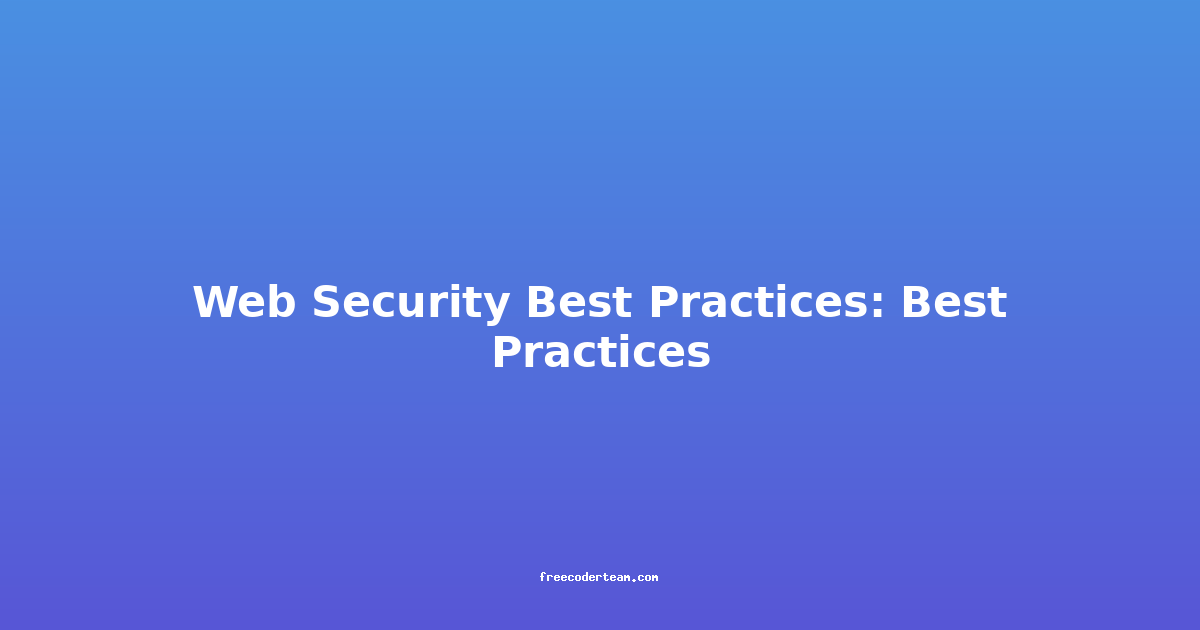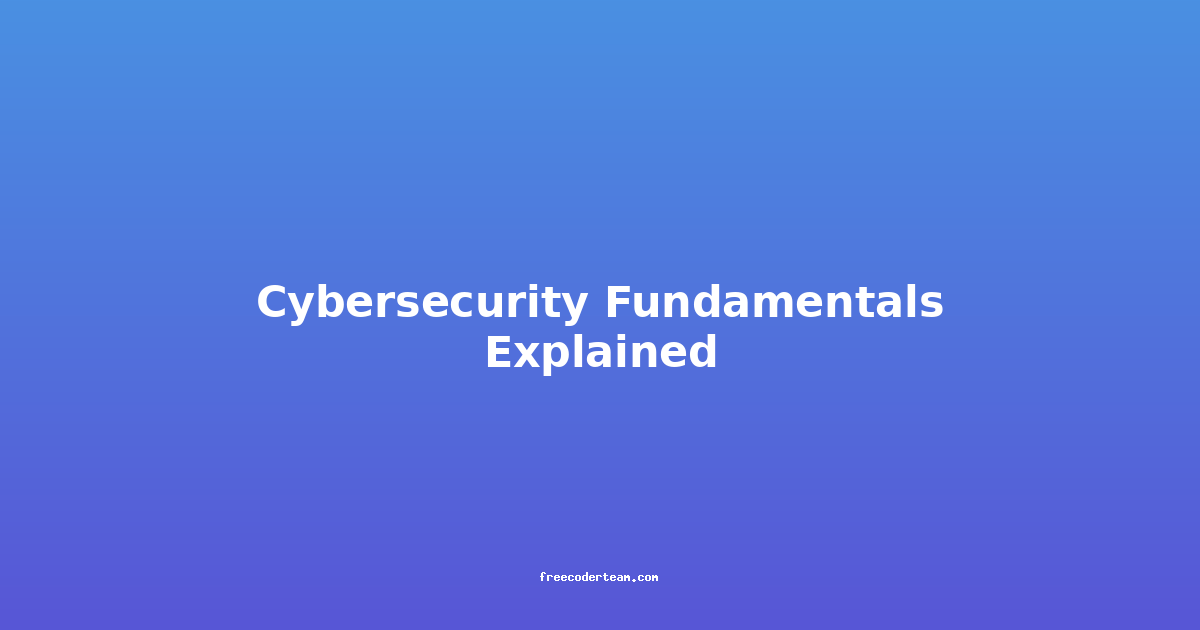Web Security Best Practices: Protecting Your Digital Fortress
In today's digital landscape, web security is more critical than ever. With cyber threats evolving rapidly, ensuring the safety of your website and its users is paramount. Whether you're a developer, sysadmin, or business owner, understanding and implementing robust security practices is essential to safeguard your online presence. In this blog post, we'll explore key web security best practices, practical examples, and actionable insights to help you fortify your web applications.
Table of Contents
- Understanding the Threat Landscape
- Best Practices for Web Security
- Practical Examples and Implementation
- Conclusion
Understanding the Threat Landscape
Before diving into best practices, it's important to understand the common threats web applications face:
- Cross-Site Scripting (XSS): Attackers inject malicious scripts into web pages viewed by other users.
- SQL Injection (SQLi): Attackers exploit vulnerabilities to manipulate database queries.
- Cross-Site Request Forgery (CSRF): Attackers trick users into performing actions they didn't intend.
- Man-in-the-Middle (MitM): Attackers intercept and alter communications between users and servers.
- Denial of Service (DoS): Attackers overload servers to make them unavailable.
By implementing robust security measures, you can mitigate these risks and protect your application.
Best Practices for Web Security
1. Input Validation and Sanitization
One of the most critical aspects of web security is properly validating and sanitizing user input. This prevents attackers from exploiting vulnerabilities like SQL injection, XSS, and command injection.
Example: Preventing SQL Injection
# Vulnerable code (SQL injection)
user_input = request.form['username']
query = "SELECT * FROM users WHERE username = '" + user_input + "'"
# Secure code using parameterized queries
import sqlite3
conn = sqlite3.connect('database.db')
cursor = conn.cursor()
user_input = request.form['username']
cursor.execute("SELECT * FROM users WHERE username = ?", (user_input,))
In the secure example, the use of parameterized queries ensures that user input is treated as data, not executable code.
2. Secure Authentication and Authorization
Implementing strong authentication and authorization mechanisms is essential to protect user accounts and sensitive data.
Example: Using HTTPS with Strong Authentication
Always enforce HTTPS to encrypt data transmitted between the client and server. Use strong authentication mechanisms like:
- Password Complexity: Enforce minimum password length and complexity requirements.
- Multi-Factor Authentication (MFA): Require additional verification (e.g., SMS codes, biometrics).
- Session Management: Use secure session tokens with short expiration times.
Code Example: Enforcing HTTPS in Express.js
const express = require('express');
const app = express();
// Redirect HTTP to HTTPS
app.use((req, res, next) => {
if (req.headers['x-forwarded-proto'] !== 'https') {
return res.redirect('https://' + req.headers.host + req.url);
}
next();
});
app.listen(3000, () => {
console.log('Server running on port 3000');
});
This ensures that all traffic to your application is encrypted.
3. Encryption and Data Protection
Encryption is vital for protecting sensitive data both at rest and in transit. Use robust encryption algorithms and secure protocols like HTTPS.
Example: Encrypting Sensitive Data
For sensitive information like passwords, use strong hashing algorithms like bcrypt or Argon2.
const bcrypt = require('bcrypt');
// Hashing a password
const password = 'securepassword123';
const saltRounds = 10;
bcrypt.hash(password, saltRounds, (err, hash) => {
if (err) throw err;
console.log('Hashed Password:', hash);
});
Always store hashed passwords instead of plain text to protect user data in case of a breach.
4. Keep Software Updated
Regularly updating your software, libraries, and frameworks ensures that you have the latest security patches. Outdated software is a major vulnerability.
Example: Managing Dependencies in Node.js
Use a package-lock.json file to lock dependency versions and ensure consistent updates.
# Update dependencies
npm update
# Lock dependencies to prevent unintended updates
npm ci
Regularly review and update your dependencies to patch known vulnerabilities.
5. Implement Security Headers
Security headers are HTTP headers that enhance the security of web applications by controlling browser behavior.
Example: Setting Security Headers in Express.js
const express = require('express');
const helmet = require('helmet');
const app = express();
// Use helmet to set security headers
app.use(helmet());
app.get('/', (req, res) => {
res.send('Secure App');
});
app.listen(3000, () => {
console.log('Server running on port 3000');
});
The helmet middleware automatically sets headers like X-Frame-Options, X-XSS-Protection, and Content-Security-Policy.
6. Use a Content Security Policy (CSP)
A Content Security Policy (CSP) helps prevent XSS attacks by specifying which content sources are trusted.
Example: Implementing CSP in Nginx
server {
listen 80;
server_name example.com;
location / {
add_header Content-Security-Policy "default-src 'self'; script-src 'self' https://trustedcdn.com; style-src 'self' https://anothercdn.com;";
}
}
This CSP allows scripts from 'self' and https://trustedcdn.com, while restricting other sources, reducing the risk of XSS attacks.
7. Regular Security Audits and Penetration Testing
Regularly conducting security audits and penetration testing helps identify vulnerabilities before attackers exploit them.
Example: Using OWASP ZAP for Pen Testing
The OWASP Zed Attack Proxy (ZAP) is a free tool for automated and manual security testing. You can use it to scan your application for vulnerabilities like XSS, SQLi, and CSRF.
- Install ZAP from OWASP.
- Start a spider to crawl your application.
- Run active scans to identify vulnerabilities.
- Review findings and fix identified issues.
Regular testing ensures your application remains secure as threats evolve.
Practical Examples and Implementation
Example 1: Implementing CSRF Protection
CSRF tokens prevent attackers from forging requests on behalf of authenticated users. Here's how to implement CSRF protection in Flask:
from flask import Flask, render_template, request, session
app = Flask(__name__)
app.secret_key = 'supersecretkey'
@app.route('/')
def home():
if 'csrf_token' not in session:
session['csrf_token'] = generate_csrf_token()
return render_template('index.html', csrf_token=session['csrf_token'])
def generate_csrf_token():
import uuid
return str(uuid.uuid4())
@app.route('/submit', methods=['POST'])
def submit():
if request.form.get('csrf_token') != session['csrf_token']:
return "Invalid CSRF token", 403
# Process the form data
return "Form submitted successfully"
Always validate the CSRF token on the server side to ensure requests are legitimate.
Example 2: Using HTTPS with Let's Encrypt
Let's Encrypt provides free TLS/SSL certificates to secure your website. Here's how to set up HTTPS using Certbot:
# Install Certbot
sudo apt update
sudo apt install certbot python3-certbot-nginx
# Obtain and install the certificate
sudo certbot --nginx -d example.com -d www.example.com
# Automatically renew certificates
sudo systemctl status certbot.timer
This ensures that your website is served securely over HTTPS.
Conclusion
Web security is a continuous process that requires vigilance and proactive measures. By implementing best practices such as input validation, secure authentication, encryption, and regular security audits, you can significantly reduce the risk of security breaches. Remember, a secure web application not only protects your data but also builds trust with your users.
Stay informed about emerging threats and best practices, and never underestimate the importance of keeping your software and systems up to date. With these insights and practical examples, you're well-equipped to fortify your web applications and protect them from malicious actors.
Stay secure, stay vigilant! 🛡️
If you have any questions or need further assistance, feel free to reach out! 📧




